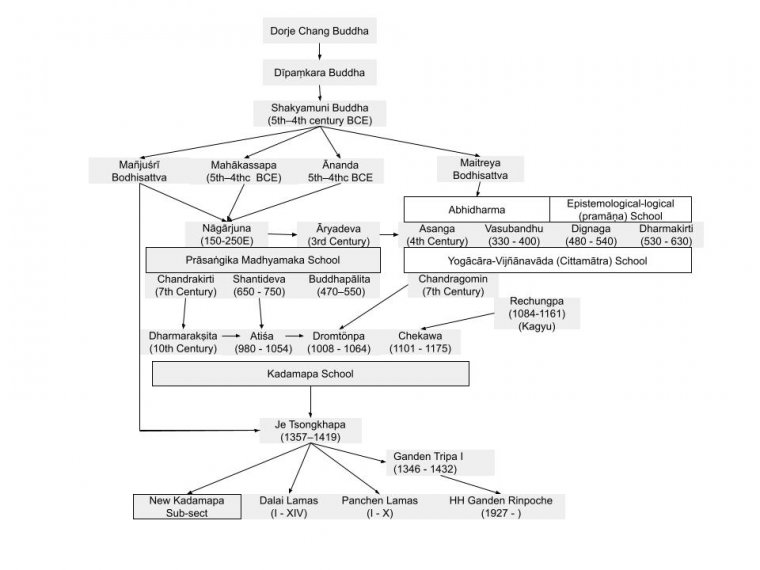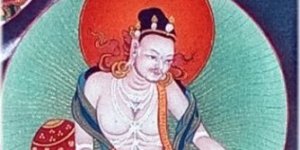| Library / Spiritual Traditions |
Gelug Tradition
The Gelug (Yellow Hat) is one of the four main traditions of Tibetan Buddhism. It is the latest of the Sarma schools1 and was founded by Tsongkhapa Lobzang Drakpa (1357-1419) in the 15th century.
Based on the Kadampa tradition founded by Atisha, it spread quickly through the activity of Tsongkhapa's many illustrious disciples, and eventually became the predominant school in Tibet, with major centers around Lhasa and in Amdo.
Tsongkhapa's followers were first known as the Gandenpas or Riwo Gandenpas, after the monastery of Ganden, which he founded, and only later became known as Gelugpas—'the Virtuous Ones'. They also became known as the New Kadampas.
Tsongkhapa

Statue of Je Tsongkhapa, on the altar in Kumbum Monastery, near Xining, Qinghai (Amdo), China. Photo by Mario Biondi, July 7, 2006Je Tsongkhapa Lobsang Drakpa, popularly known as 'Je Rinpoche', was born in the Tsongkha region of Amdo, East Tibet in 1357. An eclectic Buddhist monk, he traveled throughout Tibet studying under Sakya, Kagyu and Nyingma teachers, such as the Sakya Master Rendawa (1349–1412) and the Dzogchen master Drupchen Lekyi Dorje.
A great admirer of the Kadam school, Tsongkhapa merged the Kadam teachings of Lojong2 and Lamrim3 with the Sakya Tantric teachings. He also emphasized monasticism and a strict adherence to vinaya4.
He combined this with extensive and unique writings on Madhyamaka, the Svatantrika-Prasaṅgika distinction, and Nagarjuna's philosophy of Śūnyatā (emptiness) that, in many ways, marked a turning point in the history of philosophy in Tibet.
Tsongkhapa and his disciples founded Ganden monastery in 1409, which was followed by Drepung (1416) and Sera (1419), which became the "great three" Gelug monasteries.
After the death of Tsongkhapa the order grew quickly, as it developed a reputation for strict adherence to monastic discipline and scholarship as well as tantric practice.
Tsongkhapa had two principal disciples, Gyaltsab Je (1364—1432) and Khedrup Gelek Pelzang, 1st Panchen Lama (1385—1438).
Establishment of the Dalai Lamas
In 1577 Sonam Gyatso, who was considered the third incarnation of Gyalwa Gendün Drup, formed an alliance with the then most powerful Mongol leader, Altan Khan. As a result, Sonam Gyatso was designated as the 3rd Dalai Lama; "dalai" is a translation into Mongolian of the name "Gyatso" ocean. Gyalwa Gendün Drup and Gendun Gyatso were posthumously recognized as the 1st and 2nd Dalai Lamas respectively.
Sonam Gyatso was very active in proselytizing among the Mongols, and the Gelug tradition was to become the main spiritual orientations of the Mongols in the ensuing centuries. This brought the Gelugpas powerful patrons who were to propel them to pre-eminence in Tibet.
The Gelug-Mongol alliance was further strengthened as after Sonam Gyatso's death, his incarnation was found to be Altan Khan's great-grandson, the 4th Dalai Lama.
Emergence as dominant school
Following violent strife among the sects of Tibetan Buddhism, the Gelug school emerged as the dominant one, with the military help of the Mongol Güshri Khan in 1642.
According to Tibetan historian Samten Karmay, Sonam Chophel (1595–1657), treasurer of the Ganden Palace, was the prime architect of the Gelug's rise to political power. Later he received the title Desi (Regent), which he would earn through his efforts to establish Gelugpa power.
The 5th Dalai Lama, Ngawang Lobsang Gyatso, was the first in his line to hold full political and spiritual power in Tibet. He established diplomatic relations with Qing Dynasty China, built the Potala Palace in Lhasa, institutionalized the Tibetan state Nechung Oracle and welcomed Western missionaries.
From the period of the 5th Dalai Lama in the 17th century, the Dalai Lamas held political control over central Tibet. The core leadership of this government was also referred to as the Ganden Phodrang.
Scottish botanist George Forrest, who witnessed the 1905 Tibetan Rebellion led by the Gelug Lamas, wrote that most of the people in the Mekong valley in Yunnan were Tibetan. According to his accounts, the Gelugpas were the dominant power in the region, with their Lamas effectively governing the area. Forrest said they used "force and fraud" to "terrorise the... peasantry".
After the Incorporation of Tibet into the People's Republic of China, thousands of Tibetan monasteries were destroyed or damaged, and many Gelug monks, including the 14th Dalai Lama fled the country to India.
The three major Gelug monastic colleges (Sera, Drepung and Ganden) were recreated in India. The Dalai Lama's current seat is Namgyal Monastery at Dharamshala.
Teachings
The Gelug tradition stresses a deep and intensive study of the Buddhist scriptures. Philosophically, it follows the Prasangika Madhyamika5 viewpoint, and the tantras practiced are Guhyasamaja, Chakrasamvara, Vajrabhairava and others, such as Hevajra, Kalachakra and Vajrayogini.
In his monastic reforms, the Thirteenth Dalai Lama (1876-1934) established a formal 'geshe degree' programme of advanced training in the three great monastic universities, open to any monk.
A Geshe is a master of the five major subjects of Buddha's teachings: Perfection of Wisdom (Prajnaparamita), Middle Way (Madhyamika), Discipline (Vinaya), Phenomenology (Abhidharma) and Valid Cognition (Pramana. The title may take 15 to 25 years to complete.
Study
The Gelug school developed a highly structured system of scholastic study which was based on the memorization and study of key texts as well as formal debate. The primary topics and texts used in study are:
• Monastic discipline (vinaya): Vinaya-sutra by Gunaprabha
• Abhidharma: Vasubandhu’s Abhidharmakosha
• Epistemology (pramana ): which is based on Dharmakirti’s Pramanavarttika, a Commentary on [Dignaga’s] ‘Compendium of Valid Cognition’,
• Madhyamaka: Chandrakirti’s Madhyamakāvatāra.
• Prajnaparamita: Maitreya’s Abhisamayalankara.
Monasteries
Tsongkhapa founded the monastery of Ganden in 1409 as his main seat.

Sera Mey, Sera Monastery, IndiaDrepung Monastery was founded by Jamyang Choje, Sera Monastery was founded by Chöje Shakya Yeshe, and Tashi Lhunpo Monastery was founded by Gyalwa Gendün Drup, the 1st Dalai Lama. Before the Chinese occupation Ganden and Sera each had about 5,000 monks, while Drepung housed over 7,000.
Labrang Monastery, in Xiahe County in Gansu province (and in the traditional Tibetan province of Amdo), was founded in 1709 by the first Jamyang Zhaypa, Ngawang Tsondru. Many Gelug monasteries were built throughout Tibet as well as in China and Mongolia.
The lineage is held by the Ganden Tripas – the throne-holders of Ganden Monastery – among whom the present holder is Thubten Nyima Lungtok Tenzin Norbu, the 102nd Ganden Tripa (and not, as often misunderstood, by the Dalai Lama).
Gelug Masters
Tsongkhapa
Writings: The Great Treatise on the Stages of the Path to Enlightenment (lam rim chen mo); The Great Exposition of Secret Mantra (sngags rim chen mo); Essence of True Eloquence; Ocean of Reasoning: A Great Commentary on Nagarjuna's Mulamadhyamakakarika; Brilliant Illumination of the Lamp of the Five Stages / A Lamp to Illuminate the Five Stages; Golden Garland of Eloquence; The Praise of Relativity.
Disciples: Gyaltsab Je (1364–1431); Khedrup Gelek Pelzang, 1st Panchen Lama (1385–1438); Togden Jampal Gyatso, Jamyang Choje, Jamchenpa Sherap Senge; Gendün Drup, 1st Dalai Lama (1391–1474).
The First Dalai Lama, Gendun Drub
Writings: Sunlight on the Path to Freedom, a commentary on Abhidharma-kosa; Crushing the Forces of Evil to Dust, an epic poem on the life and liberating deeds of Gautama Buddha; Song of the Eastern Snow Mountain, a poem dedicated to Je Tsongkhapa; Praise of the Venerable Lady Khadiravani Tara, an homage to Tara.
Disciples: Khedrub Norzang Gyatso; Chokyi Shenyen; Monlam Pelwa; Chokyi Gyeltsen; Lekpai Lodro; Lodro Rinchen Sengge; Lobzang Nyima.
The Second Dalai Lama, Gedun Gyatso
Writings: Song of a Young Reincarnation; A Dance to Delight the World; Song of the Yarlung Valley; Song of the Travelling Bee; From a Vision of Lama Tsongkhapa; Meditations to Prepare the Mind for Death; Song of the Enlightenment path; Song of the Tantric Path; A Prayer of Pure Aspirations; Spiritua Advice to a Hermit; In Search of Middle View; Song of Tantric Experience; A Prayer to Spiritual Master; Song to the Three Jewels of Refuge.
Disciples: Paṇchen Sonam Drakpa; The Third Paṇchen Lama, Wensapa Lobzang Dondrub; The Twenty-First Ganden Tripa, Gelek Pelzang; Shakya Gyeltsen; Miyowa Zhonnu Lodro; Jedrung Sherab Wangpo; The Third Lelung Jedrung.
Gelug Lineage

Sources
• https://en.wikipedia.org/wiki/Gelug
• https://www.rigpawiki.org/index.php?title=Gelug
• https://www.rigpawiki.org/index.php?title=Tsongkhapa_Lobzang_Drakpa
• https://www.lamayeshe.com/article/lineage-teachings
Footnotes
1. Sarma - the New Schools of Tibetan Buddhism which followed the later translations made from the time of the great translator Rinchen Zangpo (958-1055) onwards, i.e. Kagyü, Sakya, Kadampa and Gelug.
2. Lojong is a mind training practice in the Tibetan Buddhist tradition based on a set of aphorisms formulated in Tibet in the 12th century by Chekawa Yeshe Dorje.
The practice involves refining and purifying one's motivations and attitudes. The fifty-nine or so slogans that form the root text of the mind training practice are designed as a set of antidotes to undesired mental habits that cause suffering.
They contain both methods to expand one's viewpoint towards absolute bodhicitta, such as "Find the consciousness you had before you were born" and "Treat everything you perceive as a dream", and methods for relating to the world in a more constructive way with relative bodhicitta, such as "Be grateful to everyone" and "When everything goes wrong, treat disaster as a way to wake up."
3. Lam Rim Chenmo, the Great Exposition of the Stages of the Path, is one of the great classics of Tibetan Buddhist literature presenting the stages in the complete path to enlightenment as taught by Buddha.
In Tibetan Buddhist history there have been many different versions of lamrim, presented by different teachers of the Nyingma, Kagyu, and Gelug schools.
However, all versions of the lamrim are elaborations of Atiśa's 11th-century root text A Lamp for the Path to Enlightenment (Bodhipathapradīpa). The text synthesized all of Buddha's Sutra teachings into a systematic and coherent format for study and meditation, which is still used as the backbone of practice by followers of the Gelug tradition today.
4. Vinaya - one of the three pitakas or collections of the Buddhist scriptures, concerned primarily with monastic discipline.
5. The Prasangika (Skt. Prāsaṅgika; Tib. talgyur) or 'Consequence' tradition is a subdivision of the Madhyamika school of philosophy. A defining feature of this approach is its use of consequentialist arguments (Skt. prasaṅga) to establish the ultimate truth of emptiness beyond all conceptual elaboration.
This approach was first explicitly formulated by the Indian scholar Buddhapalita and later elaborated upon and defended by Chandrakirti.
YOU MAY ALSO LIKE





